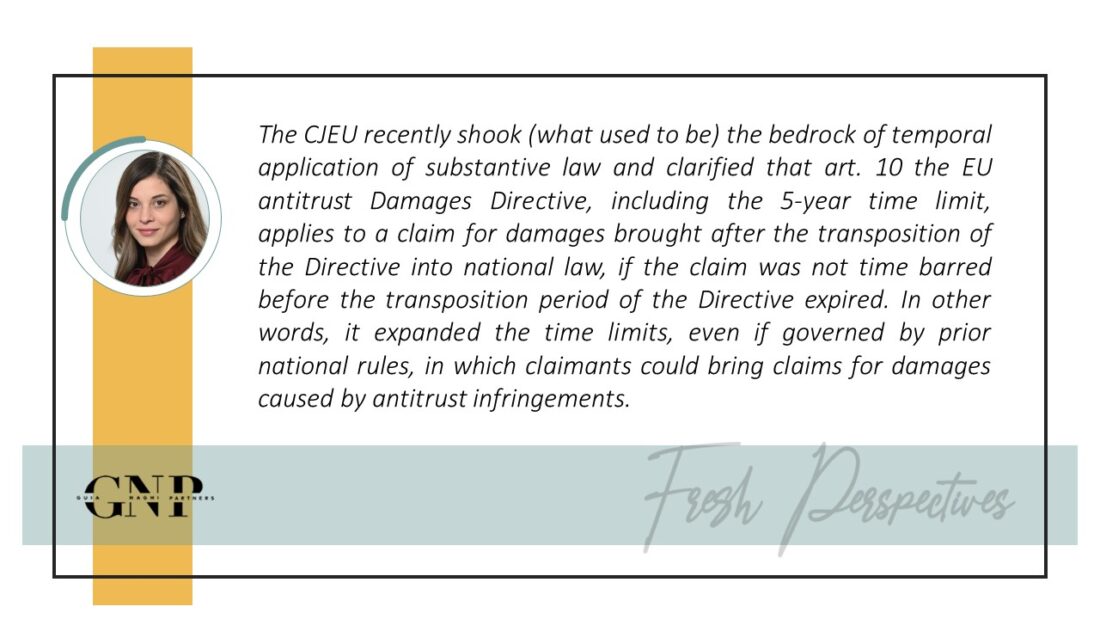Cristina Badea – CJEU puts a spin in temporal application rules on limitation periods and clarifies the scope of the EU Damages Directive. Implications for actions for damages caused by antitrust infringements
Introduction
While the CJEU Judgement of 22 June 2022 in Case C-267/20, Volvo/DAF Trucks has many issues to be unpacked, the most significant development it brings is in the field of limitation periods applicable for private damages actions brought against companies sanctioned for competition law infringements. The ruling clarifies that the limitation period starts running at the date of the publication of a Commission’s sanctioning decision in the Official Journal of the EU (“OJ”). Moreover, if the limitation period under the old rules did not expire before the date that Member States should have transposed the Damages Directive[1], and the action is brought after the transposition, then the limitation period rules, including the 5-year time limit, apply.
[1] Directive 2014/104 on certain rules governing actions for damages under national law for infringements of the competition law provisions of the Member States and of the European Union (“Damages Directive”)
The ruling also clarifies that the presumption of damage under art. 17 (2) of the Directive is a substantive norm that does not apply in a case such as the one described above, but that the court in such cases has the power to estimate the amount of harm an infringement caused, under the procedural art. 17 (1) of the Directive.
While these are also significant clarifications, the analysis and the ruling on limitation periods clearly steals the show, especially because of their supposed effect and the questions they further raise.
Context. Damages Directive: Purpose and Challenges
Companies generally understand that infringements of competition rules may end in a fine applied by the competition authority. What may however be disregarded is that the same infringement can cause a domino effect of actions against the infringer, brought by its victims. For instance, victims can claim that because of the infringement, they paid higher prices and request the difference between what was paid and what was rightfully owed. As such, the same coin – compliance with competition rules – has two sides: public and private enforcement.
The Damages Directive has the purpose to set minimum standards for private enforcement in the EU. It is generally favourable for claimants and less so for infringers because it provides for a generous limitation period of 5 years, with clear rules on its running and stay, and eases the claimants’ burden of proof. It is therefore understandable that since its adoption there have been many discussions on how the Directive applies, especially its temporal scope.
The Directive anticipated these issues and set two apparently simple rules under art. 22: substantive provisions do not apply retroactively, and procedural provision do not apply in cases brought before 26 December 2014 (i.e. the entry into force of the Directive). But what are the substantive or procedural provisions? What does “retroactive” mean? Does it matter if and when the Directive was transposed into national law?
These questions found a great playing field in private damages actions following the Commission’s record fines applied in the Trucks Cartel[1], because there are more dates that might be relevant for the application of the Directive’s 5-year limitation period: the infringement ended in 2011, was sanctioned through 2 Commission Decisions issued in 2016 and 2017, but published in the Official Journal only in 2017 and 2020. The Directive should have been transposed by December 2016, but most Member States only managed to do so in 2017 (some in 2018).
[1] https://ec.europa.eu/commission/presscorner/detail/ro/IP_16_2582 and https://ec.europa.eu/commission/presscorner/detail/en/IP_17_3502
Romanian courts were faced with an even higher challenge. The Damages Directive was initially transposed by Government Emergency Ordinance (“GEO”) no. 39 of 8 June 2017, which lasted almost 3 years before it fell before the Constitutional Court on 23 July 2020[1]. One month later, October 16, the Directive was once again transposed in Romanian law, by GEO 170/2020. This context only further scrambles the solution to the issues of limitation periods.
[1] Date of publication of the Constitutional Court Decision no 239 of 2020 in the Romanian Official Gazette no. 649 of 23 July 2020
The ruling in Case C-267/20 and the limitation period
In the aftermath of the Commission’s first Decision in the Trucks Cartel (i.e. after July 2016), sanctioning more companies including Volvo and DAF, national courts in the EU had to rule upon the limitation periods applicable to actions for damages brought based on this Decision, and the solutions varied.
a. When does the limitation period start running?
Some courts linked the running of the limitation period to the publication of the Commission’s press release[1], while others linked it to the publication of the summary decision in the OJ[2]. This was also an issue in a Romanian case brought in light of the Trucks Cartel Decision – the Bucharest Tribunal granted the time bar objection in August 2020, concluding that the limitation periods run at the date of the press release, while the Bucharest Court of Appeals disagreed on December 2021, considering that the date of publication of the summary in the OJ is relevant.
[1] The Hanover District Court decisions of December 18. 2017, 18 O 8/17, analyzed in Alex Petrasincu, The Hanover District Court finds a participant of the trucks cartel liable for damages to the city of Gottingen (MANTrucks) in Concurrences, e-Competitions News Issue, December 2017
[2] Paloma Marinez-Lage Sobredo, The Audiencia Provincial of Valencia grants in second instance 5% compensation for damages in a follow-on action based on the European Commission Decision in the truck cartel case (CNH Industrial NV) published in Concurrences no. 1 of 2020
The CJUE clarifies that generally the limitation period starts running with the publication of the summary decision in the OJ. This is relevant especially because between the press release and the publication in the OJ there may be a considerable time gap (e.g. the Commissions’ second decision in the Trucks Cartel: the press release is dated September 27, 2017, while the summary decision was published on June 30, 2020).
The CJEU leaves some room for other solutions, if the case. As such, the court considers that if there is evidence that the claimant knew the relevant details to bring its claim for damages prior to the publication in the OJ, then the limitation period can run from that date.
b. What law applies?
The CJEU clarifies that if the limitation period that was governed by the old national rules (for example, the Romanian Civil Code) did not expire at the date when the transposition deadline of the Directive expired, and the court claim is brought after the entry into force of the national law transposing the Directive, then art. 10 of the Directive on limitation periods should apply.
This extends the temporal scope of the Damages Directive past what the Advocate General advised in its opinion and may be interpreted to extend the limitation period, even if it started running under another rule, that provided for a different time limit.
However, the CJEU ruling raises many questions, relevant in the Romanian jurisdiction. First, the CJEU ruling further derogates from the Civil Code rules on temporal application of substantive law, which in turn is an application of the Constitutional principle of non-retroactive application of laws. It remains to be seen if Romanian courts reconcile national (constitutional) law with European Law.
Secondly, under Romanian law the transposition of the Directive practically occurred twice – in 2017 and 2020. Based on the CJEU ruling, what happens with court claims brought between July and October 2020, when arguably the Directive was not transposed? Even more so, if the limitation period did not elapse in December 2016 (when the Directive should have been transposed), but elapses between this date and the entry into force of the transposing law, it appears that the CJEU considers that time bar does not affect such a claim if it brought before the entry into force of the transposing law. But if so, what is the legal ground for the suspension of the limitation period, when 4 years pass between the transposition deadline and actual transposition?
Lastly, how does this ruling, together with the principle of equivalence reconcile with a claim for damages brought following a decision issued by the Romanian Competition Council, if such decisions are not published in the Romanian Official Gazette (or sometimes not even of the Council’s website)?
Conclusion
While the CJEU ruling is clearly an interesting (albeit arguably controversial) development in the field of EU private law, it appears that it may rise more questions than it answers. It remains to be seen how practitioners will interpret and apply this ruling to each case, but most likely the CJEU will be called again to clarify issues of temporal application of EU Directives.





No Comments